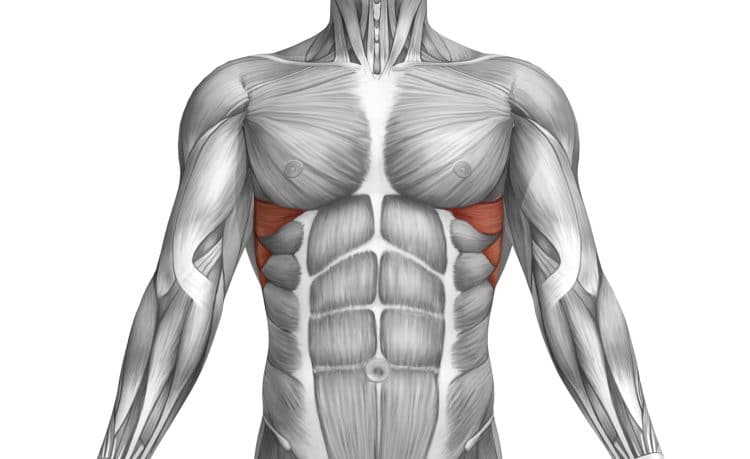Most bodybuilders and exercisers have a basic knowledge of anatomy. They know their gluteus maximus from their biceps, which exercises target what muscles, and even dedicate entire training sessions to just a couple of muscle groups.
However, with over 600 muscles in the human body, there are some muscles that are far less famous.
The serratus anterior muscle is one of those lesser-known muscles but, while you may not have heard of it, you’ve probably seen it.
When well developed, and if you’re lean enough, the serratus anterior looks like muscular fingers pointing down from your ribs to your abs. Raise your arms above your head, and you might be able to see yours!
As well as making your physique look more impressive, the serratus anterior plays a crucial role in shoulder stability. More stable shoulders mean you’ll be able to lift more weight or do more reps, making all your upper body workouts more effective.
In this article, we reveal the ten best anterior serratus exercises.
Level Up Your Fitness: Join our 💪 strong community in Fitness Volt Newsletter. Get daily inspiration, expert-backed workouts, nutrition tips, the latest in strength sports, and the support you need to reach your goals. Subscribe for free!
Serratus Anterior Anatomy

The serratus anterior is a fan-shaped muscle that wraps around the outside of your upper ribs and attaches below your scapulae or shoulder blades. From the front, it looks a little like the teeth of a saw or the edge of a serrated knife blade, which is how it gets its name.
This muscle group is responsible for the protraction of your shoulder girdle (the scapulae and clavicles). Working with your rhomboids, it also helps keep your shoulder blades together and flat against your rib cage.
Boxers often have prominent serratus anterior. That’s because it plays a critical role in punching, so it’s often called the boxer’s muscle.
Weak serratus anterior muscles can result in something called scapular winging, which is when one or both shoulder blades stick out to resemble a fish’s dorsal fin.
Scapular winging can lead to instability during pushing and pulling exercises, making them less productive and increasing your risk of injury. So, if you want to bench, curl, or row more, you need strong serratus anterior muscles.
As well as being a vital muscle for proper shoulder girdle function, a well-developed serratus anterior looks pretty cool. It frames your upper abs and obliques, enhancing the shape of your upper body.
However, if you want to see your serratus anterior in all its glory, you need to be lean. Otherwise, it’ll be hidden from view by a layer of fat.
So, while the serratus anterior is one of the lesser-known muscles, it’s still an important one, both for function and appearance.
Top Serratus Anterior Exercises
Do you want to strengthen your serratus anterior but aren’t sure where to start? Here are the TEN best exercises for this important but often neglected muscle!
1. Dumbbell serratus punch
The dumbbell serratus punch is a simple yet effective way to target your serratus anterior muscle. It also involves pectoralis minor. While you can do this exercise on a bench, it’s actually best done on the floor. Using the floor controls your range of motion and provides a stable platform so you can reset your shoulders between reps.
How to do it:
- Lie on the floor and hold a dumbbell, so your arm is vertical and straight. Pull your shoulders down and back, pressing your scapulae into the floor.
- Push your shoulder forward and press the dumbbell up toward the ceiling.
- Lower your shoulder back to the floor and repeat.
- You can also do this exercise using both arms simultaneously.
2. Scapula push-up
The name of this exercise is a little misleading because your arms remain straight, and you won’t be lowering your chest down to the floor. That said, it’s still a very effective serratus anterior exercise that can be modified to suit all abilities.
How to do it:
- Adopt the push-up position with your legs and arms straight, hands shoulder-width apart. Brace your core and pull your shoulders down and back.
- Without bending your arms, shrug your shoulders forward and spread your shoulder blades apart.
- Shrug your shoulders back again and repeat.
- Make this exercise easier by bending your legs and lowering your knees to the floor to do three-quarter scapula push-ups.
- Alternatively, bring your knee in beneath your hips to do four-point (quadruped) scapular push-ups, which are even less demanding.
3. Push-up plus
This exercise combines the scapular push-up with regular push-ups to create a functional, time-efficient workout for your chest, shoulders, triceps, and serratus anterior. If you already do push-ups, this simple tweak will increase serratus anterior activation.
Level Up Your Fitness: Join our 💪 strong community in Fitness Volt Newsletter. Get daily inspiration, expert-backed workouts, nutrition tips, the latest in strength sports, and the support you need to reach your goals. Subscribe for free!
How to do it:
- Adopt the push-up position with your legs and arms straight, hands shoulder-width apart. Brace your core and pull your shoulders down and back.
- Bend your arms and lower your chest down to within an inch of the floor.
- Extend your arms and, as your elbows straighten, shrug your shoulders forward and spread your shoulder blades.
- Reset your shoulders and repeat.
- Make this exercise easier by bending your legs and resting on your knees to do the three-quarter push-up plus.
4. Terminal bench press
The terminal bench press is a great way to train your serratus anterior when you’re at the gym and have access to a barbell and bench press station. Do this exercise before bench pressing to fire up your serratus anterior for more stable shoulders or at the end to finish it off.
Resist the temptation to go too heavy too soon with this exercise. Instead, start with an empty barbell and progress gradually. You’ll be lifting heavier weights soon enough!
How to do it:
- Lie on the bench with your eyes directly under the barbell. Reach up and hold it with a slightly wider than shoulder-width, overhand grip. Pull your shoulders back and brace your core.
- Unrack the bar and hold it over your chest, so your arms are vertical.
- Without bending your elbows, shrug your shoulder blades back and together, feeling them pressing against the bench.
- Next, spread your shoulder blades, shrug your shoulders forward, and push the bar up toward the ceiling.
- Pull your shoulders back and together, and then repeat.
5. Serratus crunch
The serratus crunch combines working your serratus anterior with strengthening your abs. As these muscles tie together and are close to one another, this exercise makes perfect sense. It’s also an excellent way to overload your rectus abdominal muscle.
How to do it:
- Lie on the floor with your legs bent and feet flat. Hold a dumbbell in each hand with your arms vertical. Use a neutral or palms-in grip. Pull your shoulders down and back, pushing your scapulae into the floor.
- Contract your abs and lift your head and shoulders off the floor.
- Simultaneously shrug your shoulders forward and push the weights straight up toward the ceiling.
- Return to the starting position and repeat.
- You can also do this exercise holding a single weight plate.
- As the weight gets heavier, it may become necessary to anchor your feet.
6. Rollouts
Rollouts are a challenging and effective core exercise that also provides your serratus anterior with a great workout. You can do rollouts from kneeling or standing and using a barbell or abs wheel as preferred. Keep your shoulders protected (shrugged forward) and your back slightly flexed to maximize serratus anterior engagement during this exercise.
You can read more about rollouts in our in-depth guide.
7. Resistance band bear hug
If you want to train your serratus anterior at home, this is the perfect exercise for you. Superset it with band pull-aparts to strengthen and stabilize your shoulder girdle anteriorly and posteriorly.
How to do it:
- Put a resistance band around your back and hold the ends. Extend your arms out to the side, hands slightly lower than shoulder height. Pull your shoulders down and back.
- Reach forward against the resistance offered by the bands and, as your hands come together in front of you, shrug your shoulders forward and spread your scapulae.
- Return to the starting position and repeat.
- At the gym, you can replicate this exercise using a cable crossover machine.
8. Dumbbell pullover
The dumbbell pullover is one of the few exercises that work your chest and back at the same time. Once a cornerstone of upper body bodybuilding training, this exercise is less common nowadays, but that doesn’t mean it’s no longer effective!
As well as being a great pec/lat workout, the dumbbell pullover is also an effective serratus anterior exercise. You can do this exercise by laying along or across a bench as preferred. However, while laying across a bench allows for a greater range of motion, it also puts more stress on your lower back.
Keep your serratus anterior engaged more by using light to moderate weights, keeping your shoulders protected, and rotating your elbows inward at all times.
Learn how to do dumbbell pullovers here.
9. Bear crawls
Bear crawls are typically done for core and conditioning purposes. They’re also a highly functional exercise that develops better agility and mobility. However, indirectly, bear crawls are also an excellent serratus anterior exercise.
That’s because you have to stabilize your shoulders and actively push the ground away as you move forward, backward, or sideways. So, if you’re looking for a fun way to train your serratus anterior, bear crawls are a great choice.
How to do it:
- Kneel down on all fours so your hands are directly under your shoulders and your knees are under your hips. Pull your toes up and press the balls of your feet into the floor.
- Brace your abs, pull your shoulders down and back, and rotate your elbows inward to engage your lats. Your lower back and neck should be neutral. Lift your knees a few inches off the floor while keeping your hips level with your shoulders.
- Without lifting your hips, move your left hand and right foot forward, and then your right hand and left foot.
- Continue crawling forward over the specified distance or number of steps.
- You can also bear crawl backward, sideways, and diagonally.
Read more about the bear crawl here.
10. Cable single-arm chest press
Cable single-arm chest presses are a great way to work your chest, triceps, core, and serratus anterior, all at the same time. No cable machine? No problem! You can also do this exercise using a resistance band.
How to do it:
- Attach a D-shaped handle to an adjustable cable machine set to about shoulder height. Hold the handle and then stand with your back to the machine so the cable runs under your arm. Adopt a split stance for stability. Brace your core and pull your shoulders down and back.
- Starting with your hand in front of your shoulder, press your arm forward and out. Do not allow your hips or shoulders to rotate.
- Shrug your shoulder forward to fully engage your serratus anterior.
- Return to the starting position and repeat.
- Do the same number of reps on both sides.
Wrapping Up
There is nothing wrong with building most of your workouts around large, prominent muscle groups like your pecs, lats, delts, and quads. But, if you want to look your best, you also need to pay attention to some of the smaller, lesser-known muscle groups. For example, the rhomboids, teres major and minor, and serratus anterior.
While these muscles won’t do a lot for your overall size, they are the “detail muscles” that separate a good physique from a great one. Some, like the serratus anterior, are also important functional muscles. Developing them will increase shoulder stability and enhance your workout, helping you to get better results.
So, while you may not have heard of the serratus anterior muscle before today, it’s clear that, for both appearance and performance, it deserves a place in your upper body workouts.
Interested in measuring your progress? Check out our strength standards for Bench Press, Push Ups, Dumbbell Pullover, and more.









Massive article about a small muscle, good job. My only gripe. If u need to go to your knees to do a pushup, you are not at the level required to give a fig about your Serratus Anterior, you need to do pushups well before even contemplating the ibs and out of any of the 600 or so individual muscles.
Thanks for your comment!
Remember, you may need to work on serratus strength for reasons other than bodybuilding, e.g., because of winging scapulae. As such, some weaker people may need to do their serratus push-ups on their knees, especially if they don’t have access to any other equipment. Kneeling serratus push-ups are a common physical therapy exercise, and an acceptable progression toward doing full push-up pluses. In some instances, they’re even done with the hands on a wall to make them more manageable.
Agreed, though, that if you are working on serratus anterior for bodybuilding purposes, you should definitely be able to do full-push-ups.
Thanks again for your input.